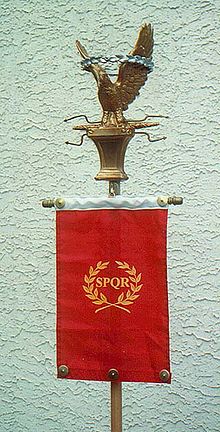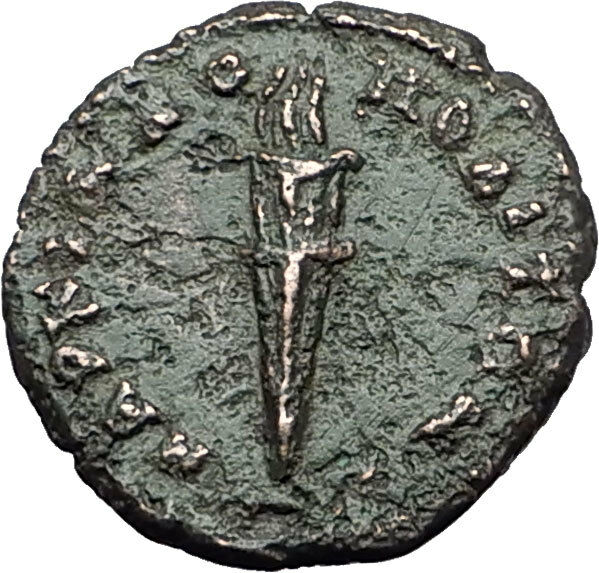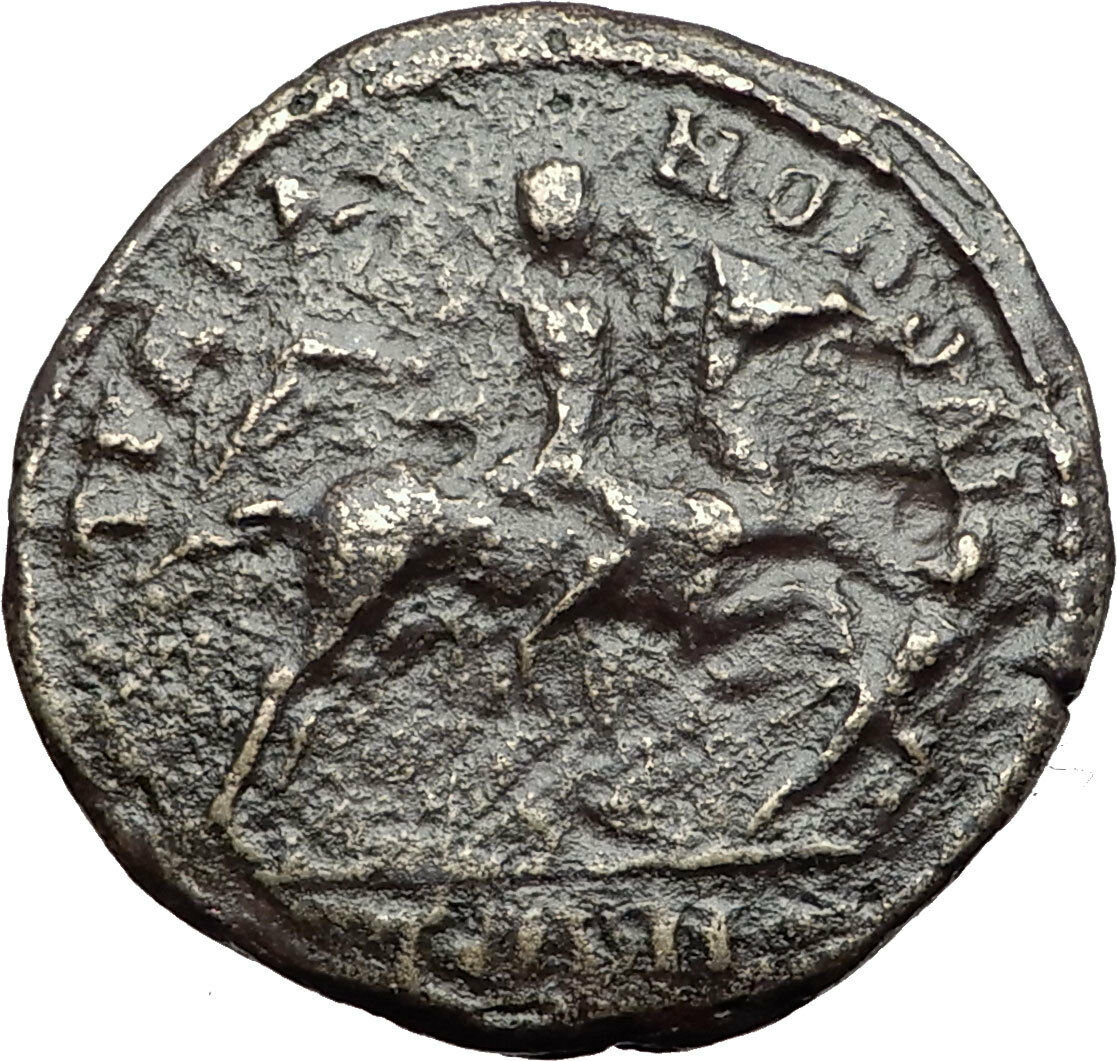|
Valerian I –
Roman Emperor: 253-260 A.D. –
Bronze 21mm (5.21 grams) of
Antioch in
Pisidia
Reference: Krzyzanowska pl. XLVIII, VII and 31
IMP CAE RASLLOVNAHHIO, radiate, draped and cuirassed bust right.
ANTIOCHIO C, vexilium surmounted by eagle, between two legionary standards; SR
in exergue.
The legends on the coins of Pisidian Antioch are usually
blundered from the time of the reign of Volusian onwards.
You are bidding on the exact item pictured,
provided with a Certificate of Authenticity and Lifetime Guarantee of
Authenticity.
The vexillum (English pronunciation: plural vexilla
was a flag
-like object used in the
Classical Era
of the
Roman Empire
. The word is itself a diminutive
for the Latin word, velum, sail, which confirms the historical evidence (from
coins and sculpture) that vexilla were literally “little sails” i.e. flag-like
standards. In the vexillum the cloth was draped from a horizontal crossbar
suspended from the staff; this is unlike most modern flags in which the ‘hoist’
of the cloth is attached directly to the vertical staff. The bearer of a
vexillum was known as a
vexillarius
or vexillifer. Just as
in the case of the regimental colors or flag of Western regiments, the vexillum
was a treasured symbol of the military unit that it represented and it was
closely defended in combat
.
Nearly all of the present-day regions of
Italy
preserve the use of vexilla. Many
Christian processional banners are in the vexillum form; usually these banners
are termed labara
(Greek:
λάβαρον) after the standard adopted by the
first Christian Roman emperor
Constantine I
which replaced the imperial eagle
with the “Chi-Rho”
symbol
☧
.
The term Vexillum is also used by the
Legion of Mary
as the term for its standard. A
small version is used on the altar and a full size Vexillum leads processions.
Jupiter is usually thought to have originated as a sky god. His identifying
implement is the
thunderbolt
, and his primary sacred animal is
the eagle, which held precedence over other birds in the taking of
auspices
and became one of the most

 common common
symbols of the
Roman army
(see
Aquila
). The two emblems were often combined to
represent the god in the form of an eagle holding in its claws a thunderbolt,
frequently seen on Greek and Roman coins. As the sky-god, he was a divine
witness to oaths, the sacred trust on which justice and good government depend.
Many of his functions were focused on the
Capitoline
(“Capitol Hill”), where the
citadel
was located. He was the chief deity of
the
early Capitoline Triad
with
Mars
and
Quirinus
. In the
later Capitoline Triad
, he was the central
guardian of the state with
Juno
and
Minerva
. His sacred tree was the oak. The
Romans regarded Jupiter as the
equivalent
of the Greek
Zeus, and in
Latin literature
and
Roman art
, the myths and iconography of Zeus
are adapted under the name Iuppiter.
An aquila, or eagle, was a prominent symbol used in
ancient Rome, especially as the
standard
of a
Roman legion
. A
legionary
known as an
aquilifer
, or eagle-bearer, carried this
standard. Each legion carried one eagle. The eagle was extremely important to
the Roman military, beyond merely being a symbol of a legion. A lost standard
was considered an extremely grave occurrence, and the Roman military often went
to great lengths to both protect a standard and to recover it if lost; for
example, see the aftermath of the
Battle of the Teutoburg Forest
, where the
Romans spent decades attempting to recover the lost standards of three legions.
Antioch in Pisidia– alternatively Antiochia in Pisidia or
Pisidian Antioch (Greek:
Ἀντιόχεια τῆς Πισιδίας) and in
Roman
Empire,
Latin
: Antiochia Caesareia or
Antiochia Caesaria – is a city in the
Turkish Lakes Region
, which is at the
crossroads of the
Mediterranean
,
Aegean
and Central
Anatolian
regions, and formerly on the border
of Pisidia
and Phrygia,
hence also known as Antiochia in Phrygia. The site lies approximately
1 km northeast of Yalvaç
, the modern town of
Isparta Province. The city is on a hill with its highest point of
1236 m in the north.
Publius Licinius Valerianus
(c. 200 – after 260), commonly known in
English
as Valerian or Valerian I, was the
Roman
Emperor
from 253 to 260.
Origins and rise to power
Unlike the majority of the pretenders during the
Crisis of the Third Centuryy
, Valerian was of a noble and traditional
senatorial
family. Details of his early life are elusive, but for his
marriage to Egnatia Mariniana
, who gave him two sons: later emperor
Publius
Licinius Egnatius Gallienus
and
Valerianus Minor
.
In 238 he was
princeps senatus
, and
Gordian I
negotiated through him for Senatorial acknowledgement for his claim as emperor.
In 251, when Decius
revived the censorship with legislative and executive powers so extensive that
it practically embraced the civil authority of the emperor, Valerian was chosen
censor
by the Senate, though he declined to accept the post. Under Decius he
was nominated governor of the
Rhine
provinces
of Noricum
and Raetia
and
retained the confidence of his successor,
Trebonianus Gallus
, who asked him for reinforcements to quell the rebellion
of Aemilianus
Rule and fall
Valerian’s first act as emperor was to make his son Gallienus
his colleague. In the beginning of his reign the affairs in Europe went from bad
to worse and the whole West fell into disorder. In the East,
Antioch
had
fallen into the hands of a
Sassanid
vassal,
Armenia
was occupied by
Shapur I
(Sapor).
Valerian and Gallienus split the problems of the empire between the two, with
the son taking the West and the father heading East to face the
Persian
threat.
By 257, Valerian had already recovered Antioch and returned
the province of
Syria
to Roman control but in the following year, the
Goths
ravaged
Asia Minor
. Later in 259, he moved to
Edessa
, but an outbreak of
plague
killed a critical number of
legionaries
,
weakening the Roman position in Edessa which was then besieged by the Persians.
At the beginning of 260, Valerian was defeated in the
Battle of Edessa
and he arranged a meeting with Shapur to negotiate a peace
settlement. The ceasefire was betrayed by Shapur who seized him and held him
prisoner for the remainder of his life. Valerian’s capture was a humiliating
defeat for the Romans.
Gibbon
, in
The History of the Decline and Fall of the Roman Empire
describes
Valerian’s fate:
The voice of history, which is often little more than the
organ of hatred or flattery, reproaches Sapor with a proud abuse of the rights
of conquest. We are told that Valerian, in chains, but invested with the
Imperial purple, was exposed to the multitude, a constant spectacle of fallen
greatness; and that whenever the Persian monarch mounted on horseback, he placed
his foot on the neck of a Roman emperor. Notwithstanding all the remonstrances
of his allies, who repeatedly advised him to remember the vicissitudes of
fortune, to dread the returning power of Rome, and to make his illustrious
captive the pledge of peace, not the object of insult, Sapor still remained
inflexible. When Valerian sunk under the weight of shame and grief, his skin,
stuffed with straw, and formed into the likeness of a human figure, was
preserved for ages in the most celebrated temple of Persia; a more real monument
of triumph, than the fancied trophies of brass and marble so often erected by
Roman vanity.
The tale is moral and pathetic, but the truth of it may very fairly be called in
question. The letters still extant from the princes of the East to Sapor are
manifest forgeries;
nor is it natural to suppose that a jealous monarch should, even in the person
of a rival, thus publicly degrade the majesty of kings. Whatever treatment the
unfortunate Valerian might experience in Persia, it is at least certain that the
only emperor of Rome who had ever fallen into the hands of the enemy, languished
away his life in hopeless captivity.
Valerian’s massacre of 258
According to the
Catholic Encyclopedia
article on
Valerian
:
Pope Sixtus
was seized on 6 August, 258, in one of the Catacombs and was put
to death;
Cyprian of Carthage
suffered martyrdom on 14 September. Another celebrated
martyr was the Roman deacon
St. Lawrence
. In Spain Bishop
Fructuosus of Tarragona
and his two deacons were put to death on 21 January,
259. There were also executions in the eastern provinces (Eusebius, VII, xii).
Taken altogether, however, the repressions were limited to scattered spots and
had no great success..
Death in captivity
An early Christian source,
Lactantius
,
maintained that for some time prior to his death Valerian was subjected to the
greatest insults by his captors, such as being used as a human footstool by
Shapur when mounting his horse. According to this version of events, after a
long period of such treatment Valerian offered Shapur a huge ransom for his
release. In reply, according to one version, Shapur was said to have forced
Valerian to swallow molten gold (the other version of his death is almost the
same but it says that Valerian was killed by being flayed alive) and then had
the unfortunate Valerian skinned and his skin stuffed with straw and preserved
as a trophy in the main Persian temple. It was further alleged by Lactantius
that it was only after a later Persian defeat against Rome that his skin was
given a cremation and burial.
The role of a Chinese prince held hostage by Shapur I, in the events following
the death of Valerian has been frequently debated by historians, without
reaching any definitive conclusion.
 <!– <!–
The Humiliation of
Emperor Valerianrian
Shapur I, pen and ink,
Hans Holbein the Younger
, ca. 1521
Some modern scholars
believe that, contrary to Lactantius’ account,
Shapur I
sent Valerian and some of his army to the city of
Bishapur
where they lived in relatively good condition. Shapur used the remaining
soldiers in engineering and development plans. Band-e Kaisar (Caesar’s
dam) is one of the remnants of Roman engineering located near the ancient city
of Susa
.
In all the stone carvings on Naghshe-Rostam, in Iran, Valerian is respected by
holding hands with Shapur I, in sign of submission.
It is generally supposed that some of
Lactantius
‘
account is motivated by his desire to establish that persecutors of the
Christians died fitting deaths;
the story was repeated then and later by authors in the Roman Near East
“fiercely hostile” to Persia.
Other modern scholars tend to give at least some credence to
Lactantius’ account.
Valerian and Gallienus’ joint rule was threatened several
times by
usurpers
. Despite several usurpation attempts, Gallienus secured the throne
until his own assassination in 268.
Owing to imperfect and often contradictory sources, the
chronology and details of this reign are very uncertain..
|






 common
common <!–
<!–


